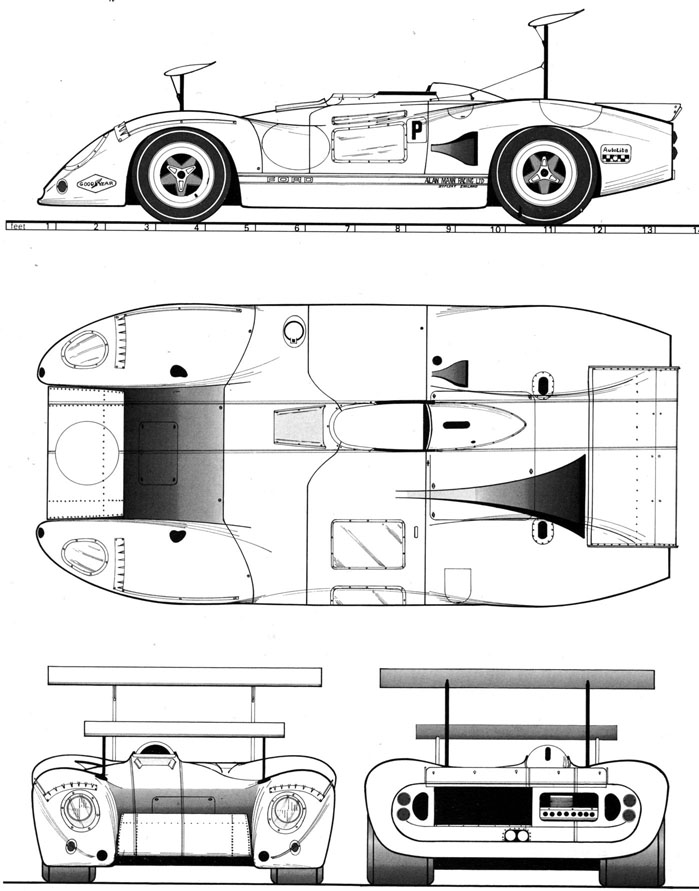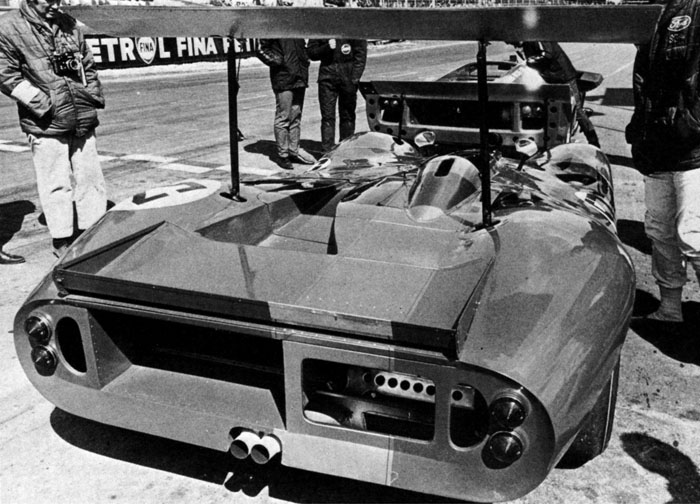RACING CARS FROM THE SIXTIES
Ford P69 - 1969
USA
Having provided Lotus with a competitive 3-litre Formula 1 engine for 1967 and several other teams with similar units in 1968, Ford of England decided to utilise their engine in a Sports/ Prototype car of their own design and manufacture to contest the 1968 Manufacturers Championship. The design of the car was entrusted to Len Bailey. who had designed the G T 40 amongst other cars, while construction and racing was handed over to Alan Mann who had previously run both rally and racing programmes for Ford with considerable success in both spheres.
The basis of the F3L (which merely stands for Ford 3 litre) is a monocoque chassis similar in concept to that of Bailey's other sports car designs, featuring a skin of 0.3in malleable aircraft alloy which is both riveted and bonded to form a very strong monocoque. The rubber fuel tanks are contained in the wide pontoons which hold 26t gallons of petrol. Steel bulkheads. assist in stiffening the chassis and also form mounting points for the suspension and other components. Unlike most of the single seaters which use the Cosworth V8 engine it is not used as a stressed part of the chassis, being fitted into the rear section of the monocoque.
Front suspension is by double wishbones in conjunction with co-axial coil spring/damper units while at the rear there are single top links, reversed lower wishbones and twin radius arms. Anti-roll bars are fitted both front and rear. Cast magnesium front spindles and rear hub carriers are fitted, the steering being by rack and pinion. A slightly unusual feature is the mounting of the I I tin Girling disc brakes inboard of the hubs to keep them in the cooling air stream instead of being buried in the wheels. Short shafts from the hubs drive the discs. Cast magnesium wheels of I sin diameter are used, the works cars being fitted with Goodyear tyres.
The car has a wheelbase of 7ft 3in which is remarkably short for a two seater, so that the driving conditions are rather cramped to say the least. The light alloy bodywork is shaped into an extremely attractive cover for the mechanical parts, with a steeply raked screen gull-wing doors and a long vortex generating tail. Although the car wa 200 lb heavier than most of the similarly powered FI cars, with a dry weight of 1,480 lh, Ford confidently expected it to be as fast on long straights by virtue of its aerodynamic shape.
The competition debut of the car was at the 1968 BOAC 500 at Brands Hatch but the drivers found it quite a handful and Jack Brabham decided not to drive it so the pairings were Mike Spence/ Bruce McLaren and J ochen Rindt/ Denny Hulme. One of the cars was given a slightly longer wheelbase to give more room and improve the handling but the team had a disastrous practice session and found itself with only one decent engine, so only Spence and McLaren got a drive. Howe~er, McLaren put in a great drive and after a poor start worked his way into the lead ahead of the works Porsches but soon after the first refuelling stop Mike Spence suffered a drive shaft breakage and the car had to be retired.
The drive shaft rubber couplings were increased in size for the next race at the Nurburgring 1000 Kms but otherwise the cars were unchanged. Gardner and Attwood were paired together while Chris Irwin and Pedro Rodriguez shared the other. During practice Chris Irwin had a severe accident in his car which put him in hospital with serious head injuries. The other car took part in the race but a series of problems with brake pads, a puncture, a broken door and finally electrical bothers put it out of the race.
At the Spa 1000 Kms Frank Gardner drove the sole remaining car and astonished everyone by lapping in 3min 36.3 sec during practice which would have been very competitive in a Formula I race on the same circuit, which bore out Ford's claim for a top speed of 200 mph. But the race was an anti-climax for it rained heavily and the electrics of the Ford were drenched, stopping the engine abruptly. The car had been fitted with ventilated discs by then which improved braking considerably.
Although the team intended to enter some more Championship races the programme was curtailed and the only other appearance of 1968 was in the Martini race at Silverstone where Gardner led the race and looked like giving the car its first win but the oil pressure dropped and he was forced to retire. This sole car was put away for the rest of the season and Bailey began work on an improved version designated
P69 (for Prototype 69) with the idea of taking advantage of the relaxed regulations concerning windscreen height, weight and fuel capacity.
The chassis design is much the same but it is fitted with an open body which is 15 in shorter, sin lower and 2.5 in wider than the 1968 car. The light alloy body panels covered almost the entire surface of the car leaving only just enough room for the driver's head to poke through the gap. The car was also intended to take every advantage of the current vogue for aerofoils and it employed a system of interconnected spoilers front and rear, the action of the two wings being controlled mechanically and hydraulically, the pitch angle being governed by wind pressure. The improved series 9 Cosworth engine was employed along with the same Hewland five-speed gearbox.
During testing drivers found the car rather unstable both on corners and on the straight and the car was entered for
the BOAC 500 of 1969 with a pair of 'conventional' free standing aerofoils mounted on the front and rear suspension uprights. The car was still not competitive with the 3-litre Porsches and when its engine failed during practice it was withdrawn from the race as no spare engine was available. The old 1968 F3L was entered for the race, now fitted with a rear suspension mounted aerofoil and in the race the aerofoil started to come loose but it retired soon afterwards when the oil pressure dropped.
The team made no further appearances in 1969, having decided that without the aerodynamic aids which were banned in May the car would have to undergo a major redesign to become competitive.
Author: ArchitectPage
More Le Mans Cars from the 60ies onwards

wheelbase 7 ft 3 ins
front track 4 ft 7 ins
rear track 4 ft 8 ins
height 2 ft 9 ins


